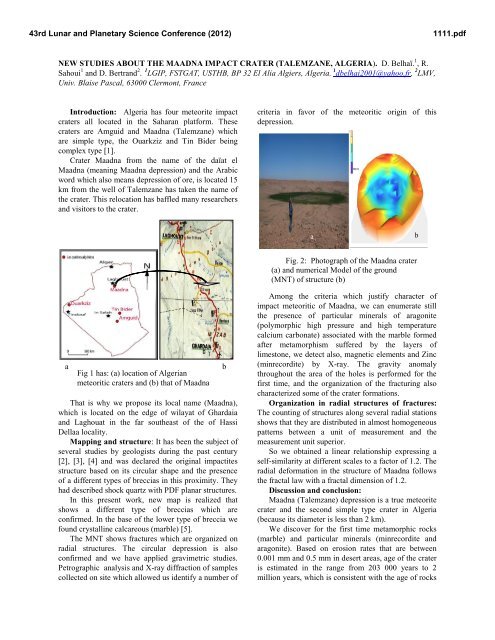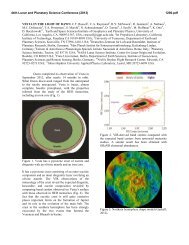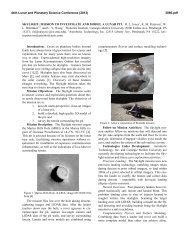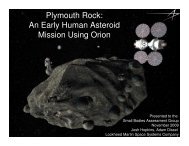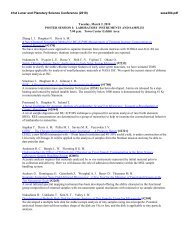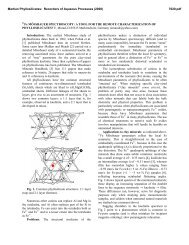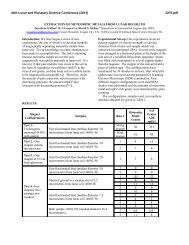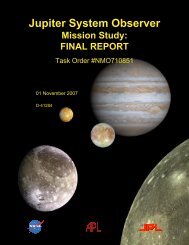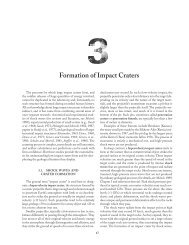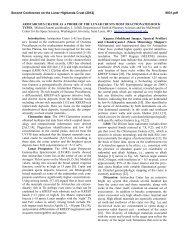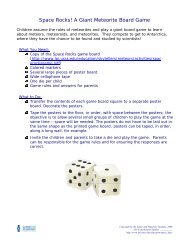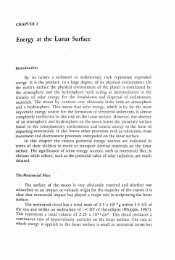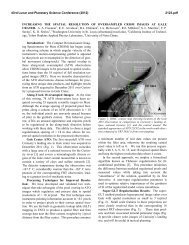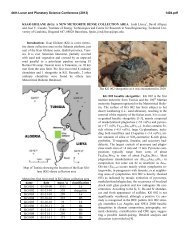New Studies about the Maadna Impact Crater (Talemzane
New Studies about the Maadna Impact Crater (Talemzane
New Studies about the Maadna Impact Crater (Talemzane
You also want an ePaper? Increase the reach of your titles
YUMPU automatically turns print PDFs into web optimized ePapers that Google loves.
43rd Lunar and Planetary Science Conference (2012)<br />
NEW STUDIES ABOUT THE MAADNA IMPACT CRATER (TALEMZANE, ALGERIA). D. Belhaï. 1 , R.<br />
Sahoui 1 and D. Bertrand 2 . 1 LGIP, FSTGAT, USTHB, BP 32 El Alia Algiers, Algeria. 1 dbelhai2001@yahoo.fr, 2 LMV,<br />
Univ. Blaise Pascal, 63000 Clermont, France<br />
Introduction: Algeria has four meteorite impact<br />
craters all located in <strong>the</strong> Saharan platform. These<br />
craters are Amguid and <strong>Maadna</strong> (<strong>Talemzane</strong>) which<br />
are simple type, <strong>the</strong> Ouarkziz and Tin Bider being<br />
complex type [1].<br />
<strong>Crater</strong> <strong>Maadna</strong> from <strong>the</strong> name of <strong>the</strong> daïat el<br />
<strong>Maadna</strong> (meaning <strong>Maadna</strong> depression) and <strong>the</strong> Arabic<br />
word which also means depression of ore, is located 15<br />
km from <strong>the</strong> well of <strong>Talemzane</strong> has taken <strong>the</strong> name of<br />
<strong>the</strong> crater. This relocation has baffled many researchers<br />
and visitors to <strong>the</strong> crater.<br />
a<br />
)<br />
Fig 1 has: (a) location of Algerian<br />
meteoritic craters and (b) that of <strong>Maadna</strong><br />
That is why we propose its local name (<strong>Maadna</strong>),<br />
which is located on <strong>the</strong> edge of wilayat of Ghardaia<br />
and Laghouat in <strong>the</strong> far sou<strong>the</strong>ast of <strong>the</strong> of Hassi<br />
Dellaa locality.<br />
Mapping and structure: It has been <strong>the</strong> subject of<br />
several studies by geologists during <strong>the</strong> past century<br />
[2], [3], [4] and was declared <strong>the</strong> original impactites<br />
structure based on its circular shape and <strong>the</strong> presence<br />
of a different types of breccias in this proximity. They<br />
had described shock quartz with PDF planar structures.<br />
In this present work, new map is realized that<br />
shows a different type of breccias which are<br />
confirmed. In <strong>the</strong> base of <strong>the</strong> lower type of breccia we<br />
found crystalline calcareous (marble) [5].<br />
The MNT shows fractures which are organized on<br />
radial structures. The circular depression is also<br />
confirmed and we have applied gravimetric studies.<br />
Petrographic analysis and X-ray diffraction of samples<br />
collected on site which allowed us identify a number of<br />
b<br />
)<br />
criteria in favor of <strong>the</strong> meteoritic origin of this<br />
depression.<br />
a<br />
Fig. 2: Photograph of <strong>the</strong> <strong>Maadna</strong> crater<br />
(a) and numerical Model of <strong>the</strong> ground<br />
(MNT) of structure (b)<br />
Among <strong>the</strong> criteria which justify character of<br />
impact meteoritic of <strong>Maadna</strong>, we can enumerate still<br />
<strong>the</strong> presence of particular minerals of aragonite<br />
(polymorphic high pressure and high temperature<br />
calcium carbonate) associated with <strong>the</strong> marble formed<br />
after metamorphism suffered by <strong>the</strong> layers of<br />
limestone, we detect also, magnetic elements and Zinc<br />
(minrecordite) by X-ray. The gravity anomaly<br />
throughout <strong>the</strong> area of <strong>the</strong> holes is performed for <strong>the</strong><br />
first time, and <strong>the</strong> organization of <strong>the</strong> fracturing also<br />
characterized some of <strong>the</strong> crater formations.<br />
Organization in radial structures of fractures:<br />
The counting of structures along several radial stations<br />
shows that <strong>the</strong>y are distributed in almost homogeneous<br />
patterns between a unit of measurement and <strong>the</strong><br />
measurement unit superior.<br />
So we obtained a linear relationship expressing a<br />
self-similarity at different scales to a factor of 1.2. The<br />
radial deformation in <strong>the</strong> structure of <strong>Maadna</strong> follows<br />
<strong>the</strong> fractal law with a fractal dimension of 1.2.<br />
Discussion and conclusion:<br />
<strong>Maadna</strong> (<strong>Talemzane</strong>) depression is a true meteorite<br />
crater and <strong>the</strong> second simple type crater in Algeria<br />
(because its diameter is less than 2 km).<br />
We discover for <strong>the</strong> first time metamorphic rocks<br />
(marble) and particular minerals (minrecordite and<br />
aragonite). Based on erosion rates that are between<br />
0.001 mm and 0.5 mm in desert areas, age of <strong>the</strong> crater<br />
is estimated in <strong>the</strong> range from 203 000 years to 2<br />
million years, which is consistent with <strong>the</strong> age of rocks<br />
b<br />
1111.pdf
43rd Lunar and Planetary Science Conference (2012)<br />
targets. The radial deformation in <strong>the</strong> structure of<br />
<strong>Maadna</strong> follows <strong>the</strong> fractal law with a fractal<br />
dimension of 1.2.<br />
Lambert in agreement with Karpoff [2], [6]<br />
suggested that <strong>the</strong> age of <strong>the</strong> formation of <strong>the</strong> crater of<br />
<strong>Talemzane</strong> (<strong>Maadna</strong>) takes place after <strong>the</strong> Pliocene and<br />
Lambert thinks that he formed between 0,5 and 3<br />
million years. This age concords with our findings.<br />
b)<br />
a<br />
)<br />
Breccia<br />
Marble<br />
Fig. 3: a) Geologic map and<br />
b) Geological cross section of <strong>Maadna</strong><br />
crater crater<br />
References: [1] Belhaï D., Merle.O., Vincent.P,<br />
Devouard B, Afalfiz. AH., 2006 : Etat des<br />
connaissances et mise au point sur les cratères<br />
météoritiques du Sahara algérien, des indicatres de<br />
pièges à hydrocarbures? Bulletin du Service<br />
Géologique de 1 ‘Algérie. Vol. 1 7, n2, p. 95-112. [2]<br />
Lambert P., Mc Hone J., Dîetz R., Houfani M., (1980):<br />
<strong>Impact</strong> and impact-like structures in Algeria. Part I:<br />
four bowl-shaped depressions: Meteoritics, y. 15, p.<br />
175-179. [3] Belhai D., Hamoudi M. et Baker H.,<br />
1999: The meteritical cratere of <strong>Maadna</strong> (Saharan<br />
Algeria). 62 nd Annual Meeting Meteoritical Society<br />
1999. Johannnesbourg (South Africa). [4] Belhai D.,<br />
Merle O., Vincent P., Devouard B. and Afalfiz A.<br />
(2005): Are <strong>the</strong> Complexe Algerian Meteorites <strong>Crater</strong>s<br />
potentials Hydrocarbon traps. 36 <strong>the</strong> Lunar and<br />
Planetary Sciences Conference (Houston Texas). [5]<br />
Sahoui R. 2009: Etude géologique et structurale du<br />
cratère météoritique du cratère de <strong>Maadna</strong>. Essai de<br />
modélisation analogique. Thèse Magister, FSTGAT,<br />
USTHB, Alger ; 160 p. [6] Karpoff R. (1954) : un<br />
cratère de "météorite" à <strong>Talemzane</strong> dans le Sud<br />
Algérien. C.R. Congrès Géol. International d'Alger,<br />
1952. Sect. 13, Fas. 14, 233-241.<br />
1111.pdf


